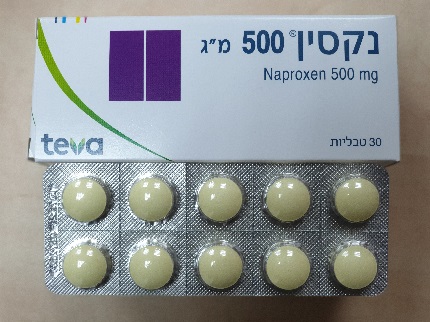Quest for the right Drug

נקסין 500 מ"ג NAXYN 500 MG (NAPROXEN)
תרופה במרשם
תרופה בסל
נרקוטיקה
ציטוטוקסיקה
צורת מתן:
פומי : PER OS
צורת מינון:
טבליה : TABLETS
עלון לרופא
מינוניםPosology התוויות
Indications תופעות לוואי
Adverse reactions התוויות נגד
Contraindications אינטראקציות
Interactions מינון יתר
Overdose הריון/הנקה
Pregnancy & Lactation אוכלוסיות מיוחדות
Special populations תכונות פרמקולוגיות
Pharmacological properties מידע רוקחי
Pharmaceutical particulars אזהרת שימוש
Special Warning עלון לרופא
Physicians Leaflet
Adverse reactions : תופעות לוואי
4.8 Undesirable effects The following adverse events have been reported with NSAIDs and with naproxen. Gastrointestinal disorders: The most commonly observed adverse events are gastrointestinal in nature. Heartburn, nausea, vomiting, constipation, diarrhoea, flatulence, dyspepsia, abdominal discomfort and epigastric distress. More serious reactions which may occur are gastro-intestinal bleeding, which is sometimes fatal, particularly in older people (see section 4.4), inflammation, ulceration, perforation, and obstruction of the upper and lower gastrointestinal tract, melaena, haematemesis, stomatitis, exacerbation of ulcerative colitis and Crohn’s disease (see section 4.4), oesophagitis, gastritis and pancreatitis. Blood and lymphatic system disorders: Neutropenia, thrombocytopenia, granulocytopenia including agranulocytosis, eosinophilia, leucopenia, aplastic anaemia and haemolytic anaemia. Immune system disorders: Hypersensitivity reactions have been reported following treatment with NSAIDs in patients with, or without, a history of previous hypersensitivity reactions to NSAIDs. These may consist of (a) non-specific allergic reactions and anaphylaxis (b) respiratory tract reactivity comprising asthma, aggravated asthma, bronchospasm or dyspnoea, or (c) assorted skin disorders, including rashes of various types, pruritus, urticaria, purpura, angio-oedema and more rarely exfoliative and bullous dermatoses (including epidermal necrolysis and erythema multiforme). Metabolic and nutrition disorders: hyperkalaemia. Psychiatric disorders: Insomnia, dream abnormalities, depression, confusion and hallucinations. Nervous system disorders: Convulsions, dizziness, headache, lightheadedness, drowsiness, paraesthesia, retrobulbar optic neuritis, inability to concentrate and cognitive dysfunction have been reported. Aseptic meningitis (especially in patients with existing auto-immune disorders, such as systemic lupus erythematosus, mixed connective tissue disease), with symptoms such as stiff neck, headache, nausea, vomiting, fever or disorientation (see section 4.4). Eye Disorders: Visual disturbances, corneal opacity, papillitis and papilloedema. Ear and Labyrinth disorders: Tinnitus, hearing disturbances including impairment and vertigo. Cardiac disorders: Oedema, palpitations, cardiac failure and congestive heart failure have been reported. Clinical trial and epidemiological data suggest that use of coxibs and some NSAIDs (particularly at high doses and in long term treatment) may be associated with a small increased risk of arterial thrombotic events (for example myocardial infarction or stroke) (see section 4.4). Vascular disorders: Hypertension, vasculitis. Respiratory, thoracic and mediastinal disorders: Dyspnoea, asthma, eosinophilic pneumonitis and pulmonary oedema. Hepatobiliary disorders: Jaundice, fatal hepatitis and abnormal liver function tests. Skin and subcutaneous tissue disorders: Skin rashes including fixed drug eruption, itching (pruritus), urticaria, ecchymoses, purpura, sweating. Alopecia, erythema multiforme, Stevens Johnson syndrome, erythema nodosum, lichen planus, pustular reaction, SLE, epidermal necrolysis, very rarely toxic epidermal necrolysis, photosensitivity reactions (including cases in which skin resembles porphyria cutanea tarda “pseudoporphyria”) or epidermolysis bullosa-like reactions which may occur rarely and drug reaction with eosinophilia and systemic symptoms (DRESS) (see section 4.4). If skin fragility, blistering or other symptoms suggestive of pseudoporphyria occur, treatment should be discontinued and the patient monitored. Musculoskeletal and connective tissue disorders: Myalgia and muscle weakness. Renal and urinary disorders: Including, but not limited to, glomerular nephritis, interstitial nephritis, nephrotic syndrome, haematuria, raised serum creatinine, renal papillary necrosis and renal failure. Reproductive system and breast disorders: Female infertility. General disorders and administration site conditions: Thirst, pyrexia, fatigue and malaise. Reporting of suspected adverse reactions Reporting suspected adverse reactions after authorisation of the medicinal product is important. It allows continued monitoring of the benefit/risk balance of the medicinal product. Any suspected adverse events should be reported to the Ministry of Health according to the National Regulation by using an online form: https://sideeffects.health.gov.il.

שימוש לפי פנקס קופ''ח כללית 1994
Rheumatoid arthritis & osteoarthritis, non rheumatic inflammatory conditions, acute gouty arthritis, dysmenorrhea
תאריך הכללה מקורי בסל
01/01/1995
הגבלות
תרופה שאושרה לשימוש כללי בקופ'ח
מידע נוסף
